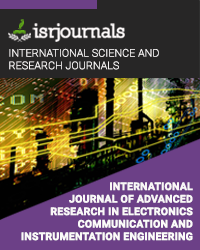cross - calibration and normalization for speckle noise reduction in sar images
N.Shanthi,C.Elayaraja
Published in International Journal of Advanced Research in Electronics, Communication & Instrumentation Engineering and Development
ISSN: 2347 -7210 Impact Factor:1.9 Volume:1 Issue:2 Year: 08 February,2014 Pages:71-77

Abstract
Speckle noise in SAR is generally more serious, causing difficulties for image interpretation. Reduction of speckle noise is one of the most essential tasks to add up the quality of radar coherent images. Filtering is one of the common methods, which is used to lessen the speckle noise. Several adaptive filtering methods have been documented to deal with this issue such as Kuan, Lee, MMSE and Frost filters. They degrade the spatial resolution of the image and also smooth the details while significantly decreasing the speckle noise level. There are also other filters such as Enhanced Lee and Gamma Map but they could not adequately suppress speckle noise. In this paper, a innovative approach for speckle reduction has been suggested and then its performance on simulated imageries with other existing filtering methods has been compared. The results have been presented by filtered output images, statistical tables and bar charts. The implementation of de-noising technique with enhancement technique as a whole is the proposed method. All the simulation is done with the help of MATLAB R2012a environment
Kewords
despeckling, enhancement, SAR image, flood maps, filters.
Reference
[1]. D.T. Kuan, A.A. Sawchuk, T.C. Strand and P. Chavel (1987). “Adaptive restoration of images with speckle.” IEEE Trans. ASSP., v. 35, no. 3, pp. 373-383. [2]. TA V.S. Frost, J.A. Stiles, K.S. Shanmugan et al. (1982). “A model for radar images and its application to adaptive digital filtering of multiplicative noise.” IEEE Trans. Pattern Analysis and Machine Intelligence, v. 4, no. 2, pp. 157-166. [3]. Anil K. Jain (1989). Fundamentals of Digital Image Processing. Prentice Hall [4]. J.-S. Lee (1981). “Speckle analysis and smoothing of synthetic aperture radar images.” Computer Graphics and Image Processing, v. 17 n., pp. 24-32. [5]. J.-S. Lee (1983). “A simple speckle smoothing algorithm for synthetic aperture radar images.” IEEE Transactions on Systems, Man, and Cybernetics, v. 13 n. 1, pp. 85-89. [6]. J.M. Durand, B.J. Gimonet et al. (1987). “SAR data filtering for classification.” IEEE Transactions on Geoscience and Remote Sensing, v. 25 n. 5, pp. 629-637. [7]. G. Franceschetti, V. Pascazio et al. (1995). “Iterative homomorphic technique for speckle reduction in synthetic aperture radar imaging.” Journal of the Optical Society of America A, v. 12 n. 4, pp. 686-694. [8]. L.J. Porcello, N.G. Massey et al. (1976). “Speckle reduction in synthetic aperture radars.” Journal of the Optical Society of America, v. 66 n. 11, pp. 1305-1311. [9]. L. Gagnon and A. Jouan (1997). “Speckle filtering of SAR images – a comparative study between complex-wavelet based and standard filters.” SPIE Int. Soc. Opt. Eng. Proc. v. 3169, pp. 80-91. [10]. Simard and Marc (1998). “Extraction of information and speckle noise reduction in SAR images using the wavelet transform.” IEEE International Geoscience and Remote Sensing Symposium Proceedings, IGARSS’98. [11]. S.G. Chang, B. Yu, and M. Vetterli (2000). “Adaptive wavelet thresholding for image denoising and compression.” IEEE Transaction on Image Processing, v. 9, no. 9, pp.1532-1546. [12]. F. Argenti and L. Alparone (2002). “Speckle removal from SAR images in the undecimal wavelet domain.” IEEE Trans. Geosci. Remote Sensing, v. 40, pp. 2363-2374. [13]. Y.Yu and S.T. Acton (2002). “Speckle Reducing Anisotropic Diffusion.” IEEE Trans. on Image Processing, v. 11, no. 11, pp. 1260—1270.

